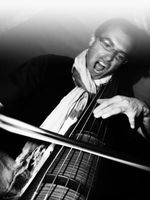-
0:00/4:25
-
0:00/4:07
-
0:00/3:58
-
0:00/4:19
-
0:00/8:12
-
0:00/7:00
-
0:00/8:19
-
0:00/4:38
-
0:00/6:43
-
0:00/4:57




dadala began in 2004 as a remix project, originally a way to recycle earlier material from RDunlap's archives (solo projects and collaborations recorded 1985-1996). The project was and is a continuation of RDunlap's long history of exploring alternative methods of creating music and audio-art, going back to the days when he bounced recordings from one cassette tape deck to another, performing live overdubs on the fly. With the second dadala album the project also began to incorporate material (already existing recordings) from a growing list of eclectic and experimental artists. Five albums were released in this mode from 2004-2006.
With the album 'candy fish barrel' in 2007 dadala settled into a core set of contributors and began to incorporate material that was newly recorded specifically for dadala's use.
As of 2011 with the album 'Spaghetti Wall' dadala had become a long-distance ensemble of four core members blending improvisation with digital alchemy, collage and serendipity. The members at that time lived in three different states in different corners of the US and with a few occasional exceptions involving brothers Richard and Frank Dunlap, they didn't ever actually record together in real time. But the project had expanded to feature original material recorded specifically for dadala, and also band members' interactions with that material (performing overdubs, remixing, etc).
Also key to dadala's transformation at that time was the addition of core member Loopy C (Chris R. Gibson) who brought vast amounts of raw material to the dadala table via his music blog "An Index of Possibilities" (sadly now unavailable) as well as private contributions, including material processed from earlier dadala tracks and member recordings. Gibson has extensive experience in the music industry, both as an artist (he was a member of Jesus Wore Dickies, among other things) and on the studio/engineering/software side of things in the background.
Starting in 2014 some new members began to come aboard and dadala became an international ensemble. As of early 2016 the current active members include Roger Sundström of Sweden (aka Erocnet - guitars and various other stringed instruments, drum kit, soundscapes and more), the ensemble's newest member Paul Mimlitsch in Colorado (aka r369improv - bass and contrabass clarinets, contrabass recorder, guitar, electronics and more) and André Darius of France (basses, vocals and more). Frank Wilke of Germany (aka brass-lines - trombone, trumpet and more) is a featured guest on many tracks. Darius, Mimlitsch and Wilke can be found on numerous releases in various collaborations from a long list of netlabels (Pan y rosas discos, Haze, Nowaki, Plus Timbre, Modisti, La bèl, Picpack, Camomille, Bruits, Ilse, TVK, Petroglyph Music, suRRism-Phonoethics...).
In 2019 dadala's track Disputed Offerings from the album The Wind was winner of the CC Community Music Award for Best Experimental Track and The Wind was a nominee for Best Experimental Album.
The way dadala tracks come together varies widely in process. Improvisation occurs not just in the instrumental performances but also in the mixing and production process. Unlike conventional and intentional composition dadala is an exploration of coincidence and synchronicity, including arbitrary elements and chance along with careful craft and manipulation. All the members of dadala get to enjoy novelty and surprise in the process.
The members contribute a wide variety of recordings ranging from unprocessed acoustic instrumental solo improvisations to elaborate experimental digital alchemy created with sophisticated cutting-edge software, equipment and techniques. Founding member RDunlap uses these recordings (along with his own occasional contributions programming and performing on a vintage Casio CZ-101 digital synthesizer) as raw material to arrange, combine, remix, edit, layer and otherwise manipulate to produce dadala.
Dunlap uses basic techniques in creating dadala mixes. While pitch shifting and/or speed changes are sometimes employed and individual notes or phrases may get moved around in the editing process, nothing is ever automatically quantized or locked to any grid, nor is any sort of "auto-tuning" applied. Everything is done "by ear" and intuitively.
Sometimes members perform overdubs to existing recordings (of their own, from other members, or premixes from RDunlap), other times completely unrelated recordings are combined. Sometimes overdubs end up being used in a different mix than they were recorded to. Sometimes material is used pretty much "as is" and combinations are left to play out as they will. Other times there is extensive editing and manipulation. It can be like building sculpture as an assemblage of disparate parts or like chiseling a statue out of a block of marble, sometimes both.
The listener is often not going to be able to tell what was intentional and what was happenstance, what was "live" and what was manipulated, or in what sequence parts were recorded. In dadala what sounds intentional was probably serendipity, and what sounds random was probably played that way on purpose.
dadalaTube
Visit our playlist at YouTube for a curated selection of fine dadala tracks, and be sure to shuffle it for best results!
